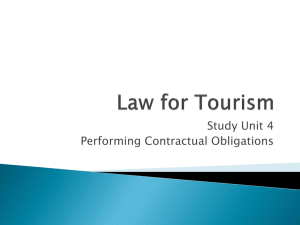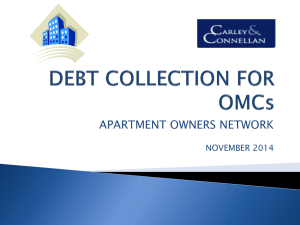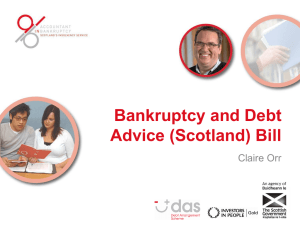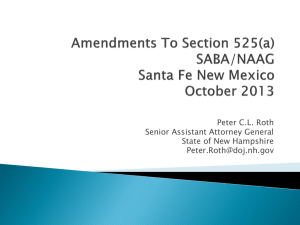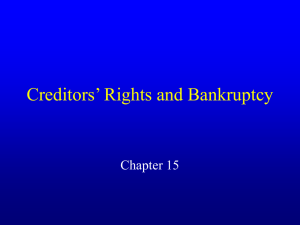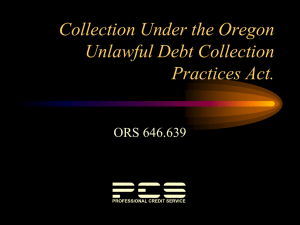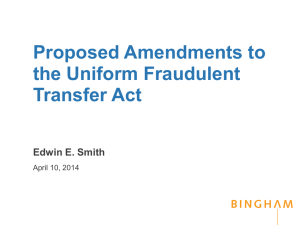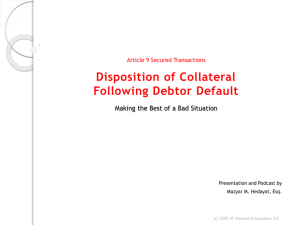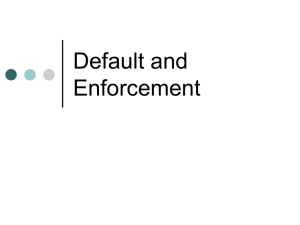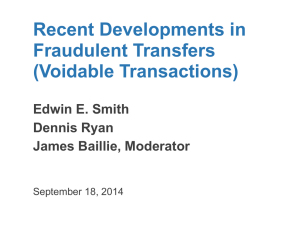MATRICS – Sequestration and Trust Deeds
advertisement
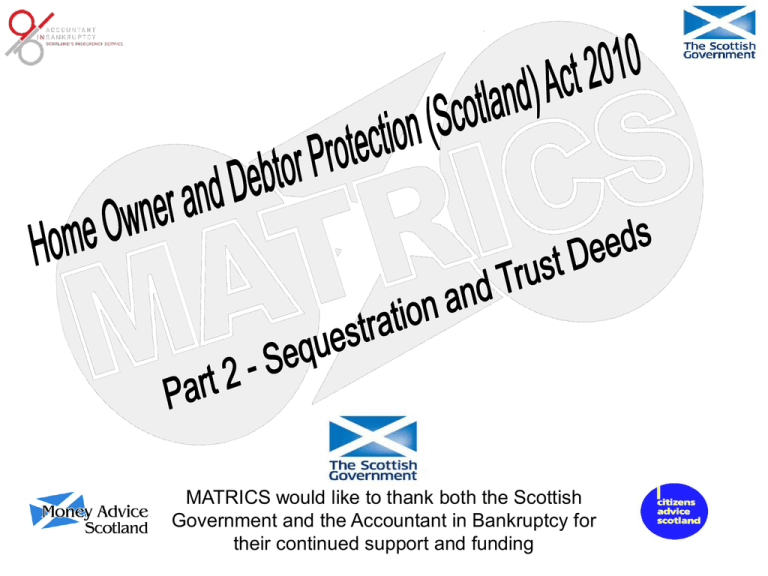
MATRICS would like to thank both the Scottish Government and the Accountant in Bankruptcy for their continued support and funding Introduction The Home Owner and Debtor Protection (Scotland) Act 2010 Part 2─Sequestration and Trust Deeds COMING INTO FORCE: 15TH NOVEMBER 2010 Part 2 of the above Act introduces a number of changes to personal insolvency Introduction Sections covered in seminar: Section 9─certificate for sequestration Section 10─trust deeds Section 11─power in relation to debtor’s family home Section 12─abolition of certain requirements to advertise in the Edinburgh Gazette Objectives To ensure that attendees are aware of : 1. How the certificated route works and what constitutes an authorised adviser 2. The change to the nature of trust deeds 3. The increased protection to the debtor’s family home 4. The abolition of advertisements in the Edinburgh Gazette PART 2 Section 9 Certificate for sequestration Routes into bankruptcy • Apparent insolvency • Granted trust deed which did not become protected • Meet low income low asset (LILA) And new route• Have certificate for sequestration from authorised person Why new route? • • • • • Still debtors outside present routes Home owners with low equity Limited income and large debts Creditors not willing to take court action Therefore unable to prove apparent insolvency • Not eligible for LILA Certificate for sequestration • Intended to open access to bankruptcy for all debtors • Those currently excluded: – Home owners with little/no equity – Those who cannot establish apparent insolvency Also removes: Creditor concurrence route S9-Certificate for Sequestration • S9 of the 2010 Act amends The Bankruptcy (Scotland) Act 1985, abolishing the concurrence of a qualified creditor route into sequestration. • It introduces a new: “Certificate for sequestration” route S9-Certificate for Sequestration • The new certificated route into sequestration is a route that is available: – When a certificate is granted by an authorised person; and – It certifies that, based on the information given to the adviser, the debtor is unable to pay debts as they become due Authorised Persons • An authorised person will be: – Persons qualified to act as insolvency practitioners in accordance with the Insolvency Act 1985 or work for IP and have been given authority by that IP to act on their behalf – Money advisers working for an agency which has been accredited at Type II* of the National Standards for Information and Advice Providers – Approved Money Adviser for the DAS – CABx money advisers – Local authority money advisers (*Agencies offering a casework service) • Authorised persons cannot be associates of the debtor as defined in S74 of the 1985 Act Certificate for sequestration • Printed on the headed notepaper of the organisation to which the authorised person belongs Form contains: – debtor details – authorised person details, signature and date – debtor declaration, signature and date Form of Certificate • A nil fee is chargeable for granting a certificate for sequestration • The Certificate for Sequestration is valid for thirty days from the date signed by the authorised person • Applications made after the 30 day period will be rejected and debtor will lose their £100 fee Certificate for sequestration DECLARATION AND SIGNATURE OF DEBTOR I _______________________________(debtor’s name,) confirm that I have provided the authorised person with correct and complete information about my financial circumstances.. I understand that this certificate is valid for thirty days including the date signed by the authorised person. ____________________________ (signature of debtor) ___________________________ (date) Advisers role • Certify that, on the basis of information provided, the debtor is unable to pay his/her debts as they become due • Provide debtor with copy of the Debt Advice and Information Package • Advise debtor of consequences of bankruptcy S9-Certificate for Sequestration • Cannot pay debts as they become due Also known as “Practical insolvency” Example: Client’s contractual payments to all unsecured debts are £350 per month. Money adviser does a financial statement using information provided by the debtor: it shows debtors only has £250 per month disposable income. Debtor, therefore, cannot afford to pay debts as they become due. This does not mean, however, they should, be sequestrated! S9-Certificate for Sequestration • Certificates can only be granted on the application of a debtor, they cannot be granted on the application of a creditor. • An authorised person must grant a certificate if and only if, the debtor can demonstrate they cannot pay their debts as they become due. • It is important to remember just because a debtor cannot pay their debts as they become due, does not mean they are insolvent! When to advise on Bankruptcy • Negative or low disposable income • No or low assets (especially equity in property) • Not possible to make a realistic repayment offer given all circumstances • Pressure of debt situation on the client Common Financial Statement • Protected Trust Deed Working Group Report recommending use of a common financial statement as industry standard • Accountant in Bankruptcy looking to adopt a Common Financial Statement Common Financial Statement • It is hoped that the AIB will introduce the MAT/BBA Common Financial Statement • Remember the CFS’s purpose is to assist in providing an accurate account of a debtor’s income and expenditure. The CFS can be accessed at: http://www.cfs.moneyadvicetrust.org/ “Different” trigger figures? • What happens if debtors contractual payments are £350 per month and money adviser draws up financial statement showing they can only afford £250. • Certificate of sequestration may be signed, but trustee in bankruptcy draws up financial statement and decides client can afford £400 per month. • Client could be asked to pay more than they were required as their debts fell due for payment. Should client have been sequestrated? Eligibility criteria • • • • Must owe £1,500 Must be living in Scotland, or; Have lived in Scotland during last year Must have not been made bankrupt in last five years • Must pay fee of £100 (up front!) Granting of Certificate • Prior to granting a certificate of sequestration, the debtor must first – Be provided with a copy of a Debtor Advice and Information Package (DAIP) – Be advised of options, where appropriate, in relation to DAS, voluntary repayment plans and trust deeds; and – Be advised of the possible consequences of sequestration – Awards of bankruptcy are recorded in a public register Consequences of Sequestration • The consequences of sequestration include the possibility of: – the debtor being refused credit, or being offered credit at a higher rate, whether before or after the date of the debtor being discharged; – the debtor not being able to remain in his/her current place of residence – the debtor being required to relinquish property which the debtor owns Consequences of Sequestration • It can also mean: – the debtor requiring to make contributions from income for the benefit of creditors (IPA/IPO) – damage to the debtor’s business interests and employment prospects; – the debtor still being liable for some debts; – the debtor’s financial transactions over the last five years being investigated; and – other restrictions or requirements imposed on the debtor as a result of the debtor’s own circumstances and actions (BRU/BRO) Agencies without authorised person Still be able to do sequestrations using: • LILA route • Apparent insolvency route Will have to signpost “certificate” clients to agencies who have authorised person QUESTIONS? Debtors Application Pack New Debtors Application Pack to be issued to be used from 15th November 2010 in line with the new regulations. Forms Changes: Redrafted the debtor application – Form 9 Redrafted statement of Assets and liabilities - now incorporated in application pack Looking to do away with the Form 17 declaration Why a new form? Part of AIB’s business plan: • Increase effective management • To ensure the debtor application process is sufficiently robust • Introduction of evidence requirements supported by new application form Note-All through consultation with stakeholders CAVEATS!!! Questions must be answered in full The fee is not refundable There may be a criminal offence if clients: Do not disclose all information Deliberately make a false statement and remember.... The fee is not refundable Form 9 • Debtor Application Form will be changed • Debtor will have to submit evidence with the application form: e.g.. – – – – – Payslips Bank statements Proof of benefits Tenancy agreement Hire Purchase / Motability agreements • Small Working Group looking at the detail • Streamline process to make it quicker for debtor Evidence requirements Evidence requirements A lot already in the adviser domain! • • • • • • Qualifying benefits Bank statements Wage slips Savings Assets Goods-HP / Lease / Motability • Policies-endowment /insurance etc • Date credit obtained • Credit agreements (liability) • Home owner/tenant (AIB land search) Evidence requirements • Some evidence is essential to make decision on sequestration option – Wage slips/bank statements – All assets/policies/insurance – HP agreements/motability/lease – Home owner – Date credit obtained Without checking above information-how can make an informed decision on client applying for sequestration? Evidence requirements • AIB working on guidance for advisers • If advisers already have the information to hand saves time to pass to AIB • And one last thought: The £100 fee is not refundable QUESTIONS? PART 2 Section 10 Trust deeds Section10: Trust Deeds • Creates a new type of trust deed where the debtors principal home will not be included – Providing a secured creditor holds a security over it; and – The secured creditor agrees before the trust deed is granted not to make a claim for any of the debt in respect of which the security is held • Trust Deed will become protected in normal way. Section10: Trust Deeds • Where there is no security, no section 10 trust deed will be possible • The secured creditor will have to, prior to the trust deed being granted; complete Form A1 • Form A1 requires the secured creditor to consent to not participate in the trust deed in relation to the secured debt, providing it receives protected status Section10: Trust Deeds • If the secured debt is excluded from the Trust Deed – The terms of repayment are not affected – The secured lender will not vote in the trust deed, nor receive a dividend – The debtor will not be discharged from their secured debts • The secured creditor will not be entitled to – Make a claim in respect of the secured debt – Do diligence against assets covered by the trust deed – Or petition for the debtor’s sequestration • Unless the debtor does not comply with their obligations owed to the secured creditor in relation to the secured debt. Exclusion of a secured creditor • Only likely to be agreed when very low equity in property • If creditors refuse to protect the trust deed client may have to amend trust deed to allow property to vest in trustee • Introduced to bring peace of mind to clients at outset of trust deed that home will not be at risk • If creditors agree to protect trust deed then property will not vest in trustee QUESTIONS? PART 2 Section 11 Power in relation to debtor’s family home Sheriff Powers in Relation to the Family Home • Currently sheriff’s on application by a trustee (in bankruptcy) to sell a family home, can: – refuse to grant the application; or – postpone granting the application for up to 12 months • Section 11 of the 2010 Act amends this power to allow the sheriff to postpone granting the application for up to 3 years. • Before applying to the Sheriff, the trustee must give notice of the proceedings to the local authority in whose area the debtor’s home is situated. Sheriff Powers in Relation to the Family Home • Where home has vested in trustee in protected trust deed the sheriff will also be able to – refuse to grant the application; or – postpone granting the application for up to 3 years – Before applying to the Sheriff, the trustee must give notice of the proceedings to the local authority in whose area the debtor’s home is situated. QUESTIONS? PART 2 Section 12 Abolition of certain requirements to advertise in Edinburgh Gazette Edinburgh Gazette • A biweekly newspaper published by Stationery Office • Not meant for public-creditors/credit reference agencies • It is not necessary for a trustee to send a notice advertising the awarding of sequestration to the Edinburgh Gazette • Proposal to amend PTD Regulations 2008 to bring trust deeds into line with sequestrations Amendment of the Debt Arrangement and Attachment (Scotland) Act 2002 • Section 11(1)(b) of the 2002 Act • Articles exempt from attachment • Vehicle which is reasonably required by the debtor • Value not to exceed £3,000 (Raised from previous value of £1,000) QUESTIONS?
